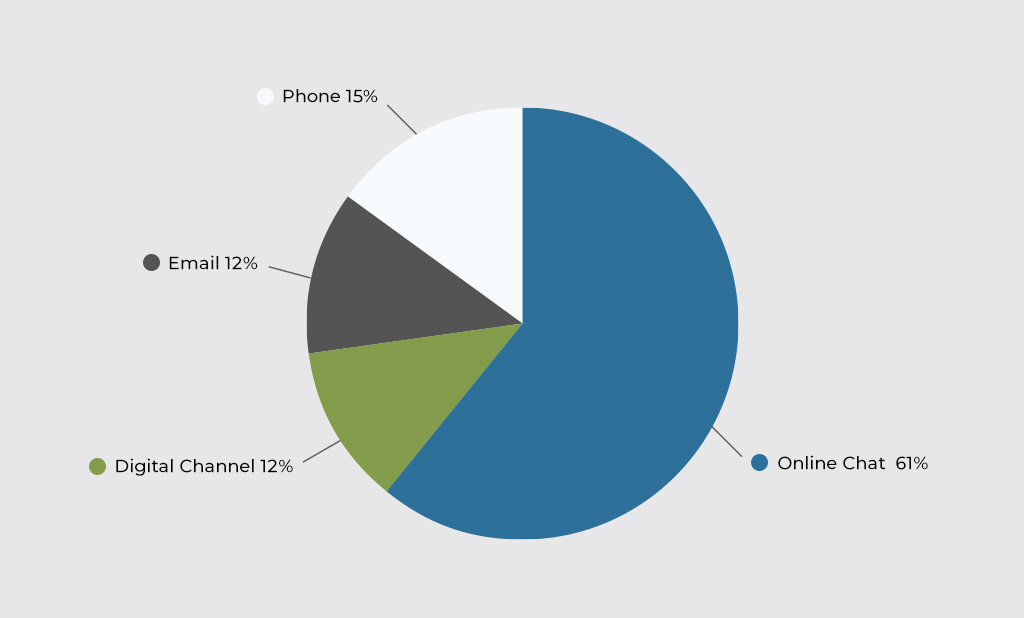Crafting Omnichannel Customer Experiences in a Digital World
In today’s digital landscape, consumers expect seamless interactions across multiple channels. Gone are the days when disjointed experiences and communication barriers were tolerated.
We’ll help you unlock the solutions to these pressing questions in our comprehensive blog, brimming with practical strategies to facilitate effortless cross-channel experiences.
Disconnected Customer Experiences
Within today’s multichannel landscapes, customer data is frequently scattered across various systems spanning different organizational touchpoints with the customer. This fragmentation poses challenges for sales and service representatives who struggle to access comprehensive customer data, resulting in an incomplete understanding of customer interactions with the business.
Shockingly, a staggering 56% of consumers have cut ties with a brand following a single negative encounter. So, how can you meet these evolving expectations? How do you leave a lasting impression on your customers through consistent, integrated conversations? More importantly, how can this approach pave the way for long-term customer loyalty?
Furthermore, this disjointed data ecosystem can detrimentally impact the online commerce experience, as not all user data gets seamlessly integrated into the online storefront, potentially leading to subpar customer experiences.

Challenges of Omnichannel Customer Experience (OCX)
Customers arrive at your doorstep with a set of lofty expectations, anticipating personalized interactions at every turn. However, meeting these expectations proves to be an uphill battle for many organizations, where communication channels have traditionally operated within isolated technology silos. These silos often lack integration and cohesive management or analytics strategies, resulting in fragmented customer experiences.
Here are some challenges in Omnichannel Customer Experience Examples:
- Lack of Personalization: Consumers anticipate personalized experiences due to their awareness of companies collecting data from them. However, gathering and consolidating data from various channels while breaking down silos remains a daunting task for many companies.
- Repeated Information: Customers seeking support encounter frustration when forced to repeat information across different channels or agents. This redundant process not only tests their patience but also dismays downstream agents.
- Disjointed Omnichannel Experiences: Modern consumers expect social media platforms to seamlessly integrate into their overall brand experience, just as much as their interactions over traditional communication channels. They anticipate meaningful two-way conversations with companies across every channel, expecting a cohesive omnichannel approach.
What Is Omnichannel Customer Experience?
Omni-channel marketing is essential for enhancing customer experience and performance, yet implementing it remains a major challenge for firms. In this blog, we explore how firms can integrate touchpoints and channels to provide superior customer experience and gain a competitive edge. Key issues include adopting a customer-centric approach, unifying touchpoints across channels, personalizing experiences, integrating channels, delighting customers, redefining physical store roles, and embracing mobile marketing.
Best Practices for Omnichannel Customer Engagement
Implementing an Omni-Channel Customer Engagement Solution like Microsoft Dynamics 365 can enhance customer relationships and loyalty. By offering personalized interactions across channels, this solution centralizes customer data for a comprehensive view. Analyzing customer behaviors allows for tailored support, ensuring consistent messaging and optimized assistance throughout their journey.
Make self-service available across channels.
Make self-service readily available across all communication channels to meet your customers’ expectations of finding help where they are. Ensure that your knowledge resources are accessible across various channels, leveraging Artificial Intelligence (AI) to enhance cross-channel self-help capabilities. Implement chatbots across your website and mobile app, embed knowledge articles in email autoresponders, and provide smart suggestions for common queries through your support portal search bar.
Scale self-service with AI
Scale your self-service capabilities with AI to accomplish two primary goals: enabling customers to solve their own problems quickly and freeing up agents to address more complex, high-value inquiries. Teach your AI-powered bot to handle simple queries, allowing your agents to focus on tasks that require their expertise.
Empower your agents with the contextual data
To ensure swift and effective responses, it’s crucial that your agents have immediate access to all relevant user information. This includes comprehensive details such as ticket history and event timelines, which provide valuable context regarding the customer’s past interactions. Additionally, insights into site navigation paths and prior contacts further enrich this contextual understanding. Armed with this complete picture, agents can respond to inquiries with clarity and confidence, ultimately delivering a more seamless and satisfying customer experience.
Route the support ticket to the right agent
Optimize your customer support process by efficiently directing inquiries to agents with the expertise to address them. Establish topic-based conversation threads, such as refunds, bookings, or cancellations, to guide customers toward the appropriate resolution path. Leveraging MS Dynamics 365, you can intelligently assign conversations to agents based on their specific skills or expertise. By automating this allocation process, you eliminate the need for constant monitoring and manual assignment, ensuring that inquiries are promptly and accurately directed to the most qualified agents.
Stay aligned with the Customer Journey
Stay aligned with the customer journey by unifying customer-related data to communicate with empathy and offer relevant solutions. Avoid requesting information that customers have already provided and ensure all agents can quickly access comprehensive customer information, including order details and past interactions.
Put the right people on the task
Likely have various teams assigned to handle different aspects based on query nature and volume. These teams may include social media managers or even members of your marketing team. However, while adept at managing online presence, they may lack the expertise to resolve support-related issues. To address this, it’s essential to distribute responsibilities across teams, ensuring a clear process for identifying, assigning, and resolving issues. This includes defining when the customer support function should step into aid, thus ensuring a cohesive and efficient approach to addressing customer queries across all channels.
Enable Multichannel Capabilities
Omnichannel customer engagement seamlessly integrates multiple communication channels into a single, unified console. This comprehensive approach ensures a smooth and unified experience for both customers and agents across different devices and touchpoints. While multichannel capabilities are essential for meeting customer needs, having too many channels without proper integration can result in disjointed experiences that frustrate both customers and agents.
True omnichannel customer engagement involves integrating disparate channels to create a unified and consistent experience. By adopting this approach, businesses can provide a seamless journey for customers, regardless of the channel they choose to interact with. This integration not only enhances customer satisfaction but also improves efficiency for agents, leading to a more positive overall experience for all parties involved.
Creating a strong Omnichannel Strategy
To deliver the most robust omnichannel customer experiences, it’s essential to seamlessly capture every interaction across all channels. Here are key features to consider:
- Visualization: This category includes features that generate graphical representations of a customer’s journey. Look for tools offering multiple prebuilt diagrams and templates, as well as customizable journey maps tailored to your business objectives.
- Collaboration: These features facilitate teamwork among individuals involved in the mapping process, allowing for shared information, updated conceptual details, and collaborative work across different work environments. This shared environment fosters effective collaboration in shaping your omnichannel strategy.
- Monitoring: This feature involves capturing crucial customer data using various business development tools, such as customer satisfaction analytics, customer experience monitoring, customer surveys, and other tools aimed at capturing the voice of the customer and their emotions. These tools enable businesses to gain insights into customer sentiment and behavior, informing strategic decisions to enhance the omnichannel experience.
To learn more about how Dynamics CRM Consulting can help you in your efforts to increase customer engagement and realize more value from your data, please contact us at info@dynamicscrmconsulting.com
Discover how cultivate enduring customer relationships that stand the test of time
Explore our Offerings


